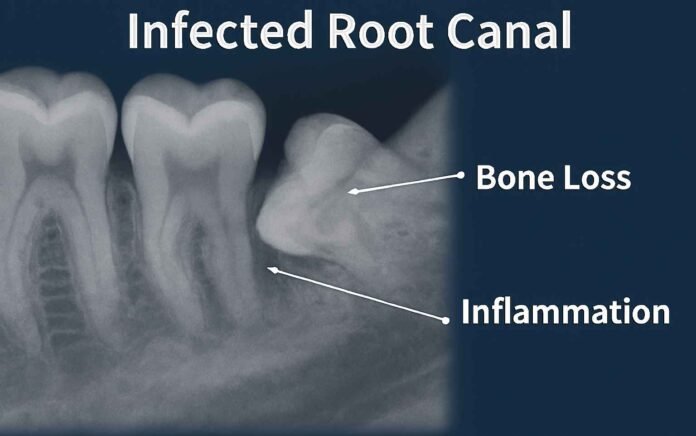
Root Canal Infected Tooth
A root canal is a common dental procedure designed to save a tooth that has become severely decayed or infected. While the treatment is often successful, in some cases, patients may experience complications leading to a root canal infected tooth. This happens when bacteria remain inside the root canal or reinfect the tooth after the procedure.
An infected root canal can cause discomfort, swelling, and in severe cases, lead to abscess formation or tooth loss. Understanding the causes, signs, and treatment options is essential for anyone who has undergone a root canal or is planning to get one.
Table of Contents
Causes and Symptoms of Root Canal Infection
Causes of Root Canal Infections
A root canal infection usually occurs due to:
- Incomplete cleaning: If bacteria remain inside the canals during the procedure, they can multiply.
- Poorly sealed filling: If the crown or filling leaks, bacteria can re-enter the tooth.
- Complex root structure: Some teeth have extra canals that may be overlooked.
- Dental trauma: Cracks in the tooth can allow bacteria to penetrate.
Symptoms of Root Canal Infections
Signs of a root canal infection are often clear and uncomfortable. They include:
- Persistent tooth pain or sensitivity to hot and cold
- Swelling in the gums or jaw around the treated tooth
- Formation of a dental abscess (pus-filled pocket)
- Darkening or discoloration of the tooth
- Bad taste or foul odor in the mouth
- Tenderness when biting or chewing
If left untreated, an infected root canal can spread infection to surrounding teeth, bone, and even bloodstream, making early detection critical.
Root Canal Infected Tooth X-Ray
One of the most reliable ways to confirm whether a root canal tooth is infected is through a dental X-ray. Dentists often recommend an X-ray when patients experience pain, swelling, or other symptoms after a root canal treatment.
An X-ray reveals the condition of the tooth’s root, surrounding bone, and any possible infection. Key signs that appear on a root canal infected tooth X-ray include:
- Dark spots near the root tip: This indicates bone loss caused by infection.
- Changes in bone density: Infection can weaken surrounding bone structure.
- Presence of abscesses: X-rays clearly show abscess formations that may not be visible to the naked eye.
- Incomplete filling: Sometimes, gaps in the filling material are visible, which allow bacteria to re-enter.
Dentists rely on X-rays not only for diagnosis but also for planning retreatment or surgical procedures. Without an X-ray, it may be impossible to fully detect hidden infection.
Treatment Options for Root Canal Infections
Treating a root canal infection depends on the severity of the case. Dentists usually recommend one of the following approaches:
Root Canal Retreatment
If the infection is caused by incomplete cleaning or poor sealing, a retreatment may be performed. The dentist removes the old filling, thoroughly cleans the canals, and reseals the tooth with new material.
Apicoectomy (Root-End Surgery)
When retreatment is not possible, a minor surgical procedure called apicoectomy may be required. The dentist removes the infected tissue and the tip of the root, sealing it to prevent further infection.
Extraction of the Tooth
In severe cases where the tooth cannot be saved, extraction may be the only option. This is followed by tooth replacement options such as a dental implant, bridge, or denture to restore function and aesthetics.
Medications for Infection
- Antibiotics: Used to control infection, especially if it has spread to surrounding tissues.
- Pain relievers: Help manage discomfort during the healing process.
- Antiseptic rinses: Keep the area clean and reduce bacterial growth.
Modern dental technology makes root canal infection treatments effective and less painful than many expect. Early diagnosis ensures better chances of saving the tooth.
Prevention and Long-Term Dental Care
Preventing a root canal infection after treatment requires a combination of professional dental care and good oral hygiene at home. A properly performed root canal can last a lifetime, but only if maintained well.
Regular Dental Check-Ups
Routine visits to the dentist help detect early signs of reinfection. Dentists often recommend a follow-up X-ray months after the procedure to ensure the tooth is healing properly.
Good Oral Hygiene Practices
- Brush at least twice a day with fluoride toothpaste.
- Floss daily to remove food particles and plaque between teeth.
- Use an antibacterial mouthwash to keep harmful bacteria under control.
Protecting the Treated Tooth
- Always get a crown after a root canal to seal and protect the tooth.
- Avoid chewing on hard objects like ice or pens, which may crack the treated tooth.
- If you grind your teeth at night, consider wearing a night guard to protect dental work.
Maintaining these habits reduces the risk of another infection and strengthens long-term oral health.
Conclusion
A root canal infected tooth is a serious condition that requires immediate dental attention. Symptoms like persistent pain, swelling, or tooth discoloration often point to a problem that may only be confirmed through an X-ray. Treatment options range from retreatment and root-end surgery to extraction in severe cases.
The good news is that with modern dentistry, most infected root canals can be successfully treated, saving the natural tooth. By following preventive care strategies such as regular dental visits, proper oral hygiene, and protecting the treated tooth with a crown, patients can avoid reinfection and maintain a healthy smile for years to come.
Read Also:
Top 10 dentists in duluth mn that are best at creating dentures
Dentists That Specialize in Partial Dentures in Duluth, MN
Understanding Periodontitis Surgery: Before and After Effects



